When you explore art across different cultures, you'll discover a universal language that transcends boundaries. From ancient symbols like Celtic knots and Egyptian ankhs to modern digital collaborations, art continues to bridge divides and foster understanding. You'll find sacred traditions merging with contemporary expressions, while traditional crafts adapt through innovative technologies. Artists serve as cultural ambassadors, sharing diverse stories and experiences that connect communities worldwide. Through art markets and international exhibitions, these creative expressions reach global audiences. The journey through humanity's artistic heritage reveals countless layers of shared experiences and unique perspectives waiting to be uncovered.
Key Takeaways
- Art transcends language barriers by communicating universal emotions and experiences through visual expressions across different cultures.
- Sacred symbols and traditional motifs reveal deep cultural beliefs while fostering appreciation for diverse spiritual perspectives.
- Digital platforms enable global artistic exchange, allowing artists worldwide to share their cultural heritage and contemporary interpretations.
- Traditional crafts preserve cultural knowledge while adapting to modern innovations, ensuring continued relevance in contemporary society.
- Artists serve as cultural bridges, facilitating understanding between communities through their work and collaborative international projects.
Ancient Cultural Symbols Today
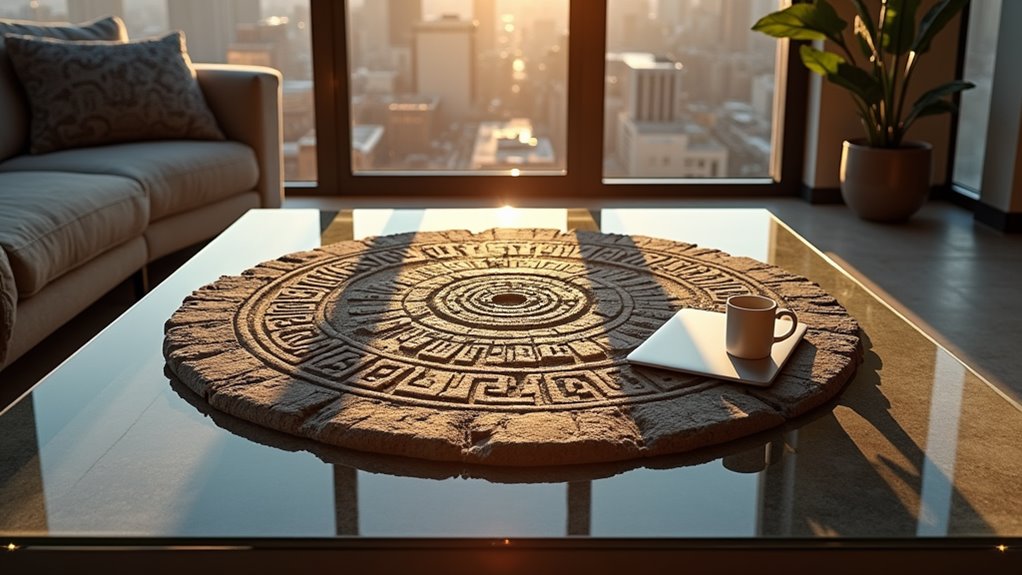
While ancient symbols once served purely religious or ceremonial purposes, they've become mainstream design elements in modern culture. You'll find Celtic knots adorning jewelry, Egyptian ankhs on t-shirts, and Native American dreamcatchers hanging in contemporary homes.
These symbols have transcended their original meanings to become aesthetic choices in fashion and décor. You might notice how these ancient motifs influence today's corporate logos, tattoo designs, and digital art.
The yin-yang symbol appears in modern wellness brands, while the Tree of Life inspires everything from book covers to wall art. What's fascinating is how you can trace these symbols' evolution from sacred significance to popular culture, where they now represent personal expression and artistic preference rather than their traditional spiritual meanings.
Global Art Movement Crossroads
You'll find that art transcends linguistic barriers as cultures mix and mingle in today's interconnected world.
When you experience artwork from different societies, you're participating in a universal dialogue that bridges divides through visual expression.
Your engagement with global art movements helps weave a tapestry of shared human experiences, where colors and forms speak a common language across borders.
Cultural Exchange Through Art
Throughout history, art has served as a universal language that transcends geographical boundaries and cultural barriers.
You'll find that when cultures meet and exchange artistic ideas, they create innovative forms of expression that blend different traditions, techniques, and perspectives.
You can see this cultural fusion in everything from Japanese ukiyo-e prints influencing European Impressionists to African masks inspiring Cubism.
As you explore contemporary art scenes, you'll notice how digital platforms have accelerated this exchange, allowing artists from different corners of the world to collaborate and share their work instantly.
When you examine these artistic intersections, you'll discover that they've played a crucial role in fostering mutual understanding between societies, challenging preconceptions, and creating new artistic vocabularies that reflect our increasingly interconnected world.
Bridging Gaps With Colors
The power of color transcends linguistic and cultural divides, building on the foundation of artistic exchange between societies.
You'll notice how certain hues evoke similar emotions across different cultures, even when their symbolic meanings vary. Red might represent luck in China but passion in Western art, yet its visual impact remains universally striking.
When you explore global art movements, you'll discover how colors bridge understanding between peoples. From the vibrant patterns of African textiles to the subtle earth tones of Japanese ceramics, each culture's palette tells a unique story.
Through modern digital platforms, you're now able to experience these chromatic dialogues instantly, connecting with artists worldwide. This accessibility has created a new language of color that's reshaping how we communicate through art.
Bridging Divides Through Visual Expression
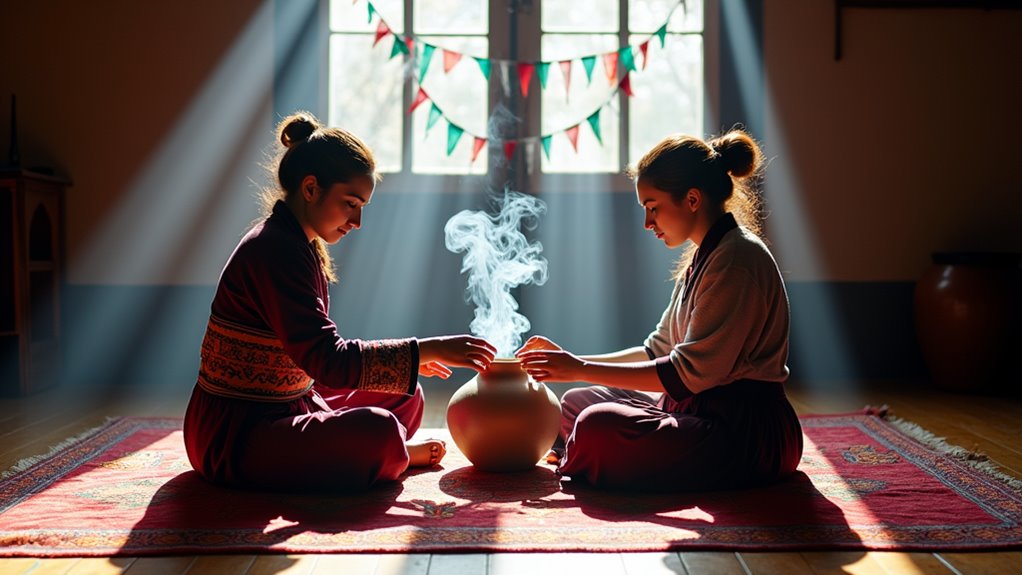
When you look at art from different cultures, you'll notice how universal symbols like spirals, circles, and geometric patterns create instant connections across borders.
You can understand an artist's raw emotions or social commentary even without speaking their language, proving art's power to communicate beyond words.
Your engagement with cross-cultural art opens pathways for creative exchange, letting you share perspectives and bridge cultural gaps through visual storytelling.
Universal Symbols Unite People
Visual symbols transcend language barriers, allowing people from different cultures to share meanings and emotions without speaking a word.
You'll find these universal symbols everywhere – from the smile that represents happiness to the heart shape that conveys love.
They're powerful tools that bridge cultural gaps and create instant connections.
When you encounter ancient cave paintings or modern emojis, you're witnessing humanity's enduring need to communicate through shared visual language.
Common symbols like the sun, moon, and stars unite people across continents and centuries.
Even abstract concepts find expression through universally recognized forms – circles represent unity, while spirals suggest growth and evolution.
These visual elements don't just connect us; they remind us of our common human experience and shared emotional vocabulary.
Art Transcends Language Barriers
Just as universal symbols unite humanity, artistic expression breaks through linguistic boundaries to touch hearts and minds across cultures.
You'll find that art speaks a language of its own, communicating complex emotions and ideas without uttering a single word.
When you encounter a powerful painting, sculpture, or dance performance, you don't need to understand the artist's native tongue to feel its impact. Through color, form, movement, and composition, artists convey universal experiences of joy, sorrow, love, and struggle.
You can stand before Van Gogh's "Starry Night" or admire traditional Chinese brush paintings, and the emotional resonance transcends any verbal barriers.
Whether it's African masks, Japanese woodblock prints, or European Renaissance masterpieces, art's visual vocabulary creates bridges between people who might never share a spoken word.
Cross-Cultural Creative Exchange
Throughout history, artists have crossed geographical and cultural boundaries to share techniques, styles, and perspectives, creating a rich tapestry of global artistic influence.
You'll find evidence of this exchange in Japanese prints inspiring European Impressionists, African masks influencing Cubism, and Chinese ceramics shaping Persian pottery designs.
When you examine contemporary art, you'll notice how digital platforms have accelerated this creative exchange. You can now instantly connect with artists worldwide, sharing your work and discovering new artistic approaches.
This unprecedented access lets you explore diverse cultural expressions and incorporate elements from various traditions into your own creative practice.
Whether you're studying traditional crafts or experimenting with modern fusion styles, you're participating in an ongoing dialogue that continues to reshape the global artistic landscape.
Sacred Art Across Civilizations
Since ancient times, sacred art has served as humanity's bridge between the earthly and divine realms. You'll find this spiritual expression in every major civilization, from Egyptian hieroglyphs to Buddhist mandalas.
When you explore sacred art, you're witnessing how different cultures visualize their deepest beliefs.
You'll notice that Hindu temples burst with colorful deities, while Islamic mosques showcase intricate geometric patterns that reflect divine perfection. Christian churches often tell biblical stories through stained glass and frescoes, while Native American sacred art connects to the natural world through totems and sand paintings.
What's fascinating is how these artistic traditions, though distinct, share common themes: the use of symbols, the quest for transcendence, and the desire to make the invisible visible through human creativity.
Digital Age Meets Traditional Craft
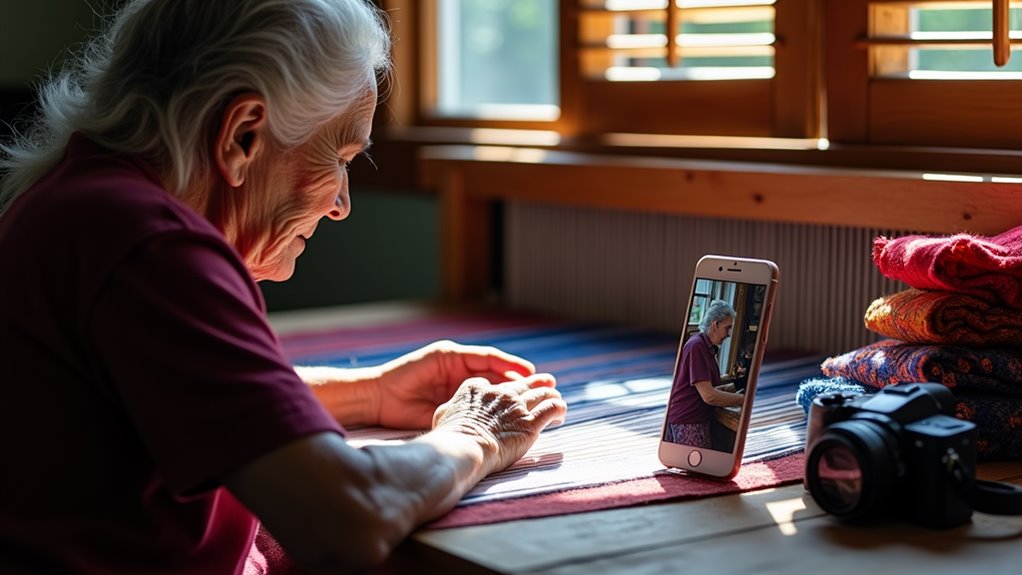
As traditional artisans embrace digital tools, we're witnessing a fascinating fusion of ancient techniques with modern technology.
You'll find woodworkers using 3D printers to create intricate templates, while pottery makers employ digital kilns that precisely control firing temperatures. These innovations aren't replacing traditional skills but enhancing them.
You can now see textile artists incorporating LED threads into traditional weaving patterns, creating luminescent fabrics that honor ancestral designs.
Digital scanning helps preserve delicate artifacts and allows craftspeople to study historical pieces in detail without handling them.
Through social media and online marketplaces, you're able to connect with artisans worldwide, learning their techniques through virtual workshops and supporting their craft directly.
This digital revolution is breathing new life into age-old traditions.
Cultural Heritage in Modern Times
When you look at today's rapidly modernizing cities, you'll find traditional craft skills and urban heritage sites increasingly at risk of being lost to time.
You're witnessing a critical moment where preserving these cultural treasures requires both innovative approaches and community engagement.
Your role in supporting local artisans and advocating for heritage protection can help bridge the gap between historical preservation and contemporary development.
Preserving Traditional Craft Skills
Although traditional craft skills have endured for generations, they're increasingly at risk of disappearing in our digital age. You'll find that many ancient techniques for pottery, weaving, and metalwork are now practiced by only a handful of artisans worldwide.
You can help preserve these vital cultural practices by supporting local craftspeople, attending workshops, or documenting traditional methods. When you learn traditional crafts, you're not just acquiring a skill – you're becoming part of an unbroken chain of cultural knowledge that stretches back centuries.
Consider seeking out apprenticeships or joining preservation societies in your area. By participating in these age-old practices, you'll help ensure that future generations can experience the richness of handmade crafts and understand the cultural significance behind each traditional technique.
Urban Heritage Protection Today
While rapid urbanization threatens historic buildings and neighborhoods, cities worldwide are implementing innovative preservation strategies to protect their cultural heritage.
You'll find cities using digital mapping to document architectural details and creating heritage zones with strict development guidelines. Many municipalities now offer tax incentives to property owners who maintain historic features.
You can see successful urban heritage protection in action through adaptive reuse projects, where old industrial buildings become cultural centers or historic homes transform into boutique hotels.
Cities are also engaging communities in preservation efforts, recognizing that local residents are crucial stakeholders.
Through walking tours, educational programs, and public consultations, you're now able to participate directly in protecting your city's unique character and historical fabric.
Artists as Cultural Ambassadors
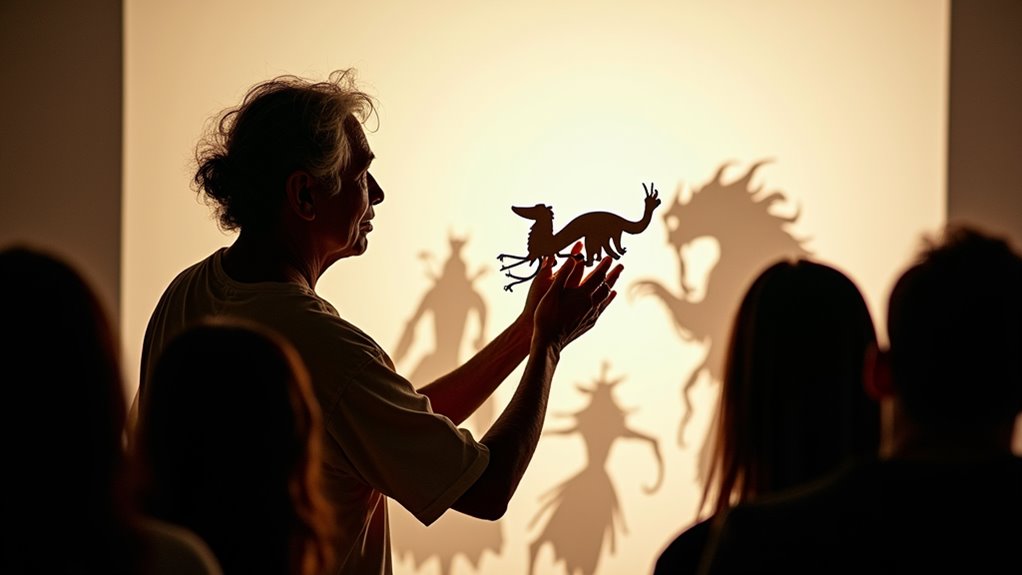
How do artists bridge the gaps between diverse cultures and societies? They serve as cultural ambassadors, translating unique perspectives and traditions through their creative works. You'll find artists breaking down barriers by sharing stories, emotions, and experiences that resonate across borders.
When you examine the role of artists in cultural exchange, you'll notice they're often the first to forge connections between different communities. Through music, visual arts, dance, and literature, they're able to communicate universal human experiences while celebrating distinct cultural identities.
You can see this when international artists collaborate, mixing traditional and contemporary elements to create new forms of expression. Their work helps you understand different worldviews and challenges your preconceptions, making them powerful agents of cross-cultural understanding and social change.
Borrowed Elements in World Art
This natural flow of cultural exchange has led artists throughout history to borrow and reimagine elements from other traditions.
You'll find Japanese prints influencing European Impressionists, African masks inspiring Cubist painters, and Islamic geometric patterns appearing in Western architecture.
When you examine art history closely, you'll notice that some of the most innovative works emerge from these cultural intersections.
Consider how Chinese porcelain designs transformed European ceramics, or how Indian textiles revolutionized British fashion. These aren't mere copies – they're creative interpretations that breathe new life into established forms.
Today's global connectivity has accelerated this artistic cross-pollination.
You can see how contemporary artists blend cultural elements more freely than ever, creating works that transcend traditional boundaries while respecting their original contexts.
Preserving Artistic Traditions
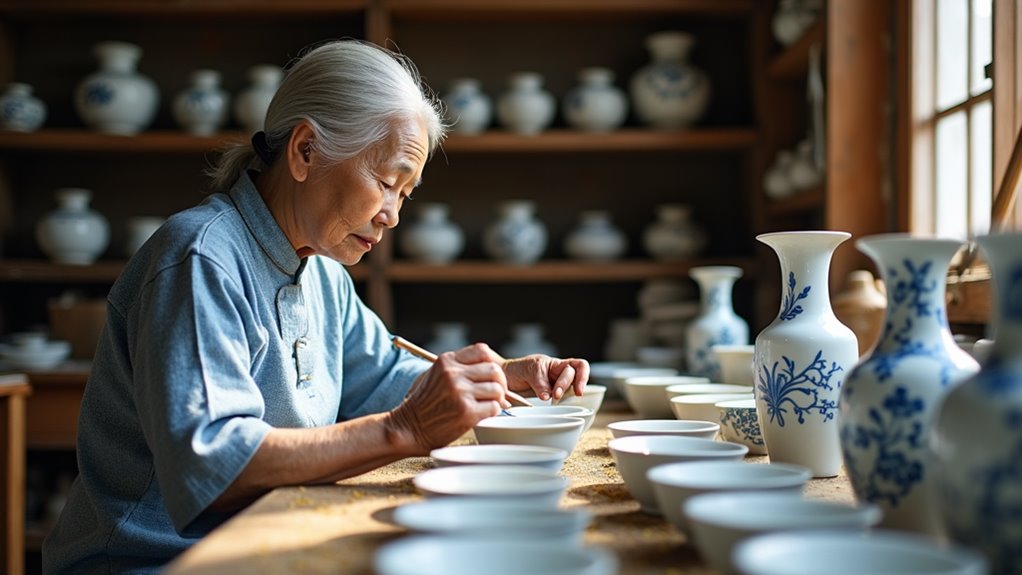
Although cultural exchange enriches art, preserving traditional techniques and knowledge remains vital for maintaining cultural heritage.
You'll find that many ancient artistic practices face extinction as modern methods replace time-honored processes. By documenting and teaching these traditions, you're helping ensure their survival for future generations.
You can support artistic preservation by visiting cultural centers, participating in workshops, and purchasing authentic traditional art.
When you learn about indigenous painting techniques, traditional weaving patterns, or ceremonial pottery methods, you're becoming part of the preservation process.
Consider how master artisans pass down their skills through apprenticeships and formal training programs.
These efforts help protect unique artistic expressions that might otherwise disappear, from intricate basket weaving to complex textile designs that tell stories of cultural identity.
Art Markets Shape Cultural Exchange
Global art markets serve as powerful catalysts for cultural exchange, connecting artists and collectors across geographical boundaries. You'll notice how these markets enable diverse artistic expressions to reach new audiences, fostering appreciation for different cultural perspectives and traditions.
When you explore contemporary art fairs, auction houses, and online platforms, you'll find they've created unprecedented opportunities for artists from various backgrounds to showcase their work internationally. These venues don't just facilitate sales; they're instrumental in spreading cultural understanding and appreciation.
You'll see how collectors who purchase art from different cultures often become ambassadors for those traditions, sharing stories and meanings behind the pieces they acquire.
The market's influence extends beyond economics, shaping how you perceive and value art from different societies.
Frequently Asked Questions
How Do Different Cultures Interpret the Same Colors in Their Artwork?
You'll find that color interpretations vary dramatically across cultures.
While you might see red as passion or danger in Western art, it represents good fortune in Chinese culture.
White symbolizes purity in Western traditions but signifies mourning in many Asian societies.
Blue can mean nobility in European art but represents immortality in Egyptian works.
These contrasts reflect each culture's unique historical and spiritual perspectives.
What Role Does Music Play in Influencing Visual Art Across Cultures?
Did you know that 72% of artists report listening to music while creating their work?
You'll find that music profoundly shapes visual art across cultures, influencing everything from rhythm in brush strokes to color choices.
In Japanese art, you'll notice how traditional shamisen music inspires flowing lines, while African drum rhythms often translate into bold, geometric patterns.
Music's tempo and mood directly affect artists' creative expression and composition style.
How Do Weather Patterns Affect Traditional Art Materials and Techniques?
You'll find that weather patterns dramatically shape how artists work with their materials. In humid regions, you'll see techniques adapted for moisture resistance, like lacquerware in Southeast Asia or sealed pottery.
Dry climates favor rock art and mineral-based pigments that won't fade in intense sun. Cold weather influences the use of durable materials like stone and bone, while tropical conditions often lead to art using natural fibers and water-resistant treatments.
Which Ancient Art Techniques Have Completely Disappeared From Modern Practice?
You'd be surprised to learn that few ancient art techniques have truly vanished.
While some, like Maya blue pigment production and Roman concrete making, were lost for centuries, they've been rediscovered through modern research.
What you might consider "disappeared" techniques often survive in modified forms.
The closest examples are certain Egyptian faience glazing methods and specific Mesopotamian metalworking processes that we haven't fully decoded.
How Do Political Tensions Affect Cultural Art Exchanges Between Nations?
Political tensions can directly limit your access to other nations' art through sanctions, travel bans, and exhibition restrictions.
You'll notice how diplomatic conflicts often lead to canceled cultural programs and restricted artist mobility. When relations sour, you might find museums withdrawing loans of artifacts, galleries canceling shows, and cultural exchange programs getting suspended.
Yet you'll also see how art sometimes bridges these divides, becoming a tool for diplomatic healing.
Conclusion
As you stand at the crossroads of global artistic expression, you're weaving threads between past and present like a master tapestry maker. You'll find that art flows like water across cultural boundaries, seeping into the cracks between societies and sprouting new hybrid forms. In today's interconnected world, you're not just an observer but a participant in this rich mosaic of human creativity.
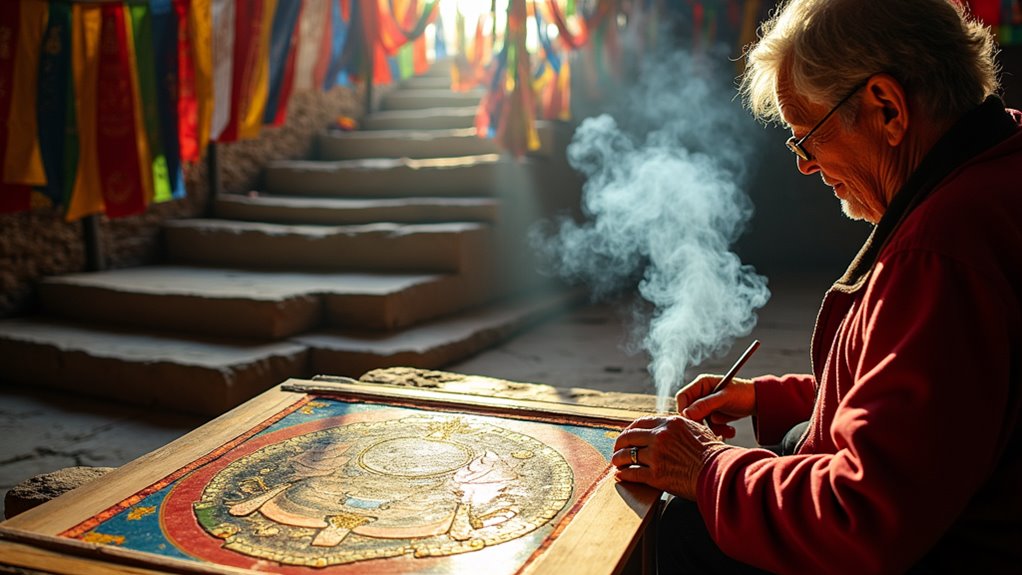
Leave a Reply